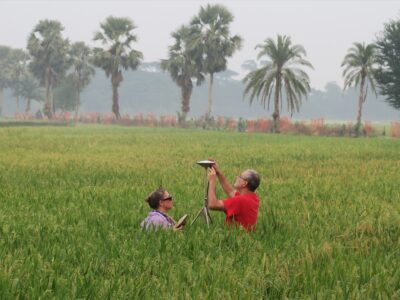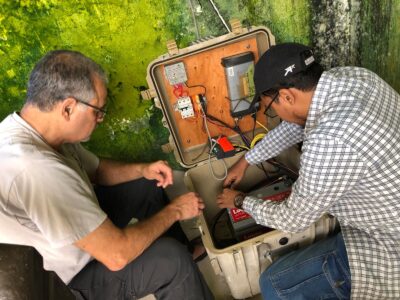
Due to the COVID-19 pandemic, it has been almost two years since I was last in Bangladesh. During this time, all of the GNSS (GPS) receivers that we set up in 2018 and 2019 for two different projects have stopped working. As a result, I will be here for three and a half weeks to visit and repair them all with the help of Dhaka University graduate Sanju Singha. He has been critical in maintaining the stations.

The first stage of this trip is visiting our five stations in Sylhet, in the northeastern part of Bangladesh. This is the area where the sediments of the delta are being folded up by the IndoBurma subduction zone. The folds form hills whose tops are covered by forests. The flanks are used for tea plantations, generally called tea gardens. The intervening valleys are covered by rice paddies. Beneath the folds lies the nearly horizontal subduction megathrust, a fault that could potentially rupture in a great earthquake. Over years, our GNSS stations can measure the motion of the ground down to rates of 1 mm/year or better, to better understand the fault movement.


Sanju and I left Dhaka, the capital, on December 29 with Babu, who has been our driver whenever we can manage it since 2005. On the way to Srimongal, where we will be staying, we stopped at our first station in Chunarughat. It is in the middle of one of the valleys at a college. Now I got to see how bad things looked inside the equipment box. The waterproof box kept all the leaked fluids inside and the acid fumes corroded everything.

The wood was nearly black, exposed connectors were all green, as were the ends of the copper wires. The corrosion meant the solar panels weren’t supplying power and the batteries were drained and ruined. We even found that the SIM card in the modem was corroded and had to be replaced, along with the modem. We spent hours cleaning and replacing everything. Amazingly, the expensive GNSS receiver, despite the corrosion on the unused connectors, worked fine. UNAVCO was able to remotely program the new modem. The station is now up and running again. Success!
We headed to Srimongal and picked up Shofiqul Islam, a professor at a university in Sylhet city at the train station. Shofique spent 7 months at Lamont in 2021 working with me on the folding and thrusting of the hills in Bangladesh.

The next day we headed east to service the two farthest stations. The ICPS station is on the roof of a primary school on the flank of one of the hills reached through driving on bad roads in a remote area. The roads are barely wider than our van, so passing other vehicles is always a challenge. This time, we could get the receiver working, but were missing a key cable connecting the receiver to the modem. Without a replacement, we had to leave it without a being able to transmit the data. However, it is recording the data internally. On my next trip, I will bring the needed parts and Sanju will complete the repairs.

We took a short cut to the JURI station on the other side of the hill. Instead of going around the hill, we went across it through the tea gardens and then an eco park. This station is in a medical clinic. They would like us to move the receiver out of the birthing room, but this will have to happen on another trip. This time the modem was ok and after the repairs, JURI is back online. The problem at this station is that trees growing around the clinic are blocking antenna’s view of the sky. This has been a problem at this station before. Betel nut trees are partially blocking the view to the north, but the worst is a tree whose branches overhand the antenna. Sanju will have to speak to the clinic director next week about cutting down, or at least trimming, the trees. Looking at the previous data from the site, I can see the recent data is about three times less precise than the older data.

The fourth station, SSPS, also on a primary school, was vandalized by someone to steal the batteries. The broken box was no longer waterproof and the rain ruined the receiver. However, a sixth site had to be removed because they expanded the school it was on, adding a new floor where our antenna was mounted. We installed the KGPS receiver in place of SSPS, but relocated the box to inside the school in a secure storeroom. This made for a longer job. We had to reinstall the solar panel, and add a grounded lightning protector to the antenna cable for safety before it enters the school. Still, we were able to finish in time to get Shofique to his train back to Sylhet. The SSPS site is in a beautiful location, but hard to get to. The concrete culverts over the little streams stood above the dirt road making it challenging for the van to drive over. We had to get out several times to lighten the van and at one site we made a brick roadway so the van could drive across. It worked and we could drive up to the site instead of having to carry the batteries and equipment the last half mile.
After finishing, we had tea and cookies, along with some hard-boiled eggs that Sanju ordered from a nearby store, in the mud and bamboo home of the head of the school maintenance committee. Then, for New Year’s Eve, we stopped for an afternoon snack at a fancy resort with its own tea garden followed by tea at a local tea shack. The contrast in style and price was striking.

Our final station was also at a school. It is on the top of the hill nearest to Srimongal, the tea capital of Bangladesh. The repairs were similar, except for a mix-up about the solar panel that cost us time. We are now on our way back to Dhaka. While we were there, the school children arrived to get new books for New Year’s Day. We have repaired all five GNSS stations and restored remote data transfer at three of them — overall, a pretty successful first phase of my trip. Now I will spend the next week in Dhaka, culminating in attending a Bangladeshi wedding before heading south to visit nine more stations by car and boat.

The data from these stations are helping to refine our estimates of the rate at which subduction is occurring. They are being used by graduate student Bar Oryan at Lamont as part of his thesis. The longer the time series of the data from the GNSS sites, the more accurate the estimate of the subduction rate and overall tectonics. The results are already showing the rate is a little slower than I previously estimated, which hopefully means a longer time between potentially disastrous earthquakes.



